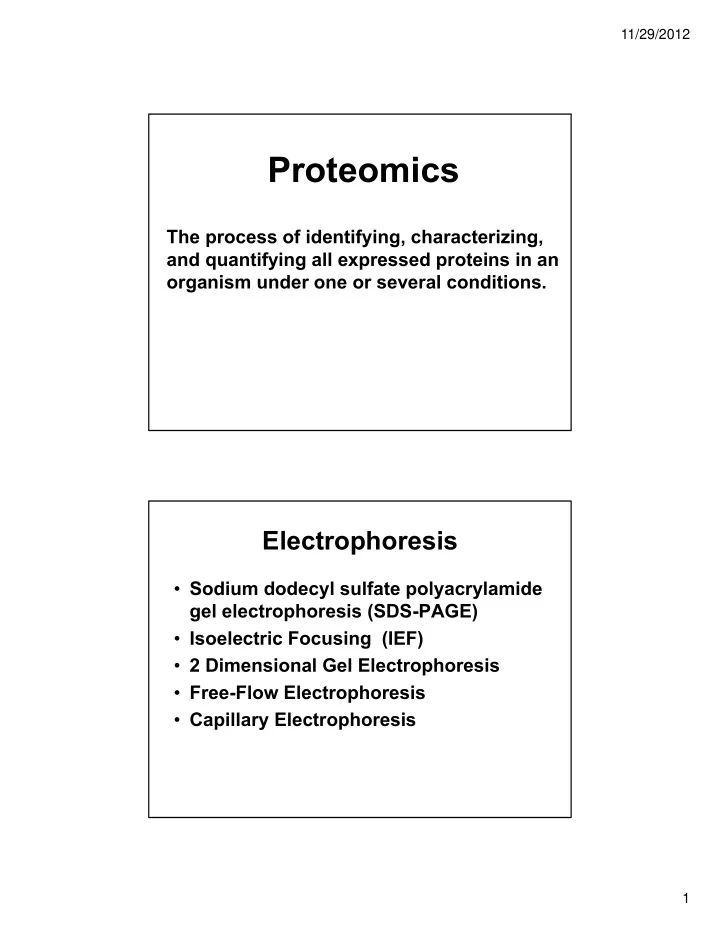

11/29/2012 Proteomics The process of identifying, characterizing, and quantifying all expressed proteins in an organism under one or several conditions. Electrophoresis • Sodium dodecyl sulfate polyacrylamide gel electrophoresis (SDS-PAGE) • Isoelectric Focusing (IEF) • 2 Dimensional Gel Electrophoresis • Free-Flow Electrophoresis • Capillary Electrophoresis 1
11/29/2012 SDS-PAGE • Separates proteins by size • Denaturing gels • Resolution dependent on – Size of polyacrylamide gel – Concentration of acrylamide • one concentration or a gradient – Stacking of sample • Stain to visualize proteins – Multiple stains available with varying sensitivity • Deep Purple, sypro ruby, sypro orange, silver IEF • Separation by charge • pH gradient established by ampholytes • Gel matrix – polyacrylamide strips with immobilized pH gradient. – pH gradients in ranges from 3-11 NL to one pH unit (i.e. 6-7) in lengths of 7cm to 28 cm strips – Tube gels • Run times – Immobilized IEF 6-24 hours – Vertical/tube gels IEF 2-6 hours 2
11/29/2012 Figure is from “Principles of Biochemistry” Lehninger, Fourth Edition 2D gel electrophoresis • Perform IEF • Place IEF gel in large well of SDS gel and perform electrophoresis • Stain • Cut out spots to identify by mass spectrometry 3
11/29/2012 2D Gel Electrophoresis 4
11/29/2012 R Tonge, J Shaw, B Middleton, R Rowlinson, S Rayner, J Young, F Pognan, E Hawkins, I Currie, M Davison (2001) Validation and development of fluorescence two-dimensional differential gel electrophoresis proteomics technology . Proteomics 1:377-396 18 18 27 27 37 42 42 37 31 31 42 37 68 89 99 69 56 76 68 68 89 99 76 69 69 89 56 99 56 76 5
11/29/2012 Spot Identification Accession # Avg. T- % ratio test Cov 31 Mitochondrial Chaperonin 60 2.68 0.002 51 AAA33452.1 (Zea Mays) 27 Similar to Heat-shock protein 1.88 0.046 20 NP_001066882.1 precursor 242 Not analyzed 1.69 0.022 ---- -------- 18 Victorin Binding Protein, Avena sativa 1.58 0.040 33 AAA63798.1 (glycine decarboxylase P subunit) 37 1.38 0.001 14 Dihydrolipoamide dehydrogenase NP_001042918.1 family protein (glycine decarboxylase L AK330954 subunit) 38 Not analyzed 1.35 0.014 ---- -------- 76 Serine hydroxymethyltransferase 1.31 0.002 25 AAA33687.1 69 Serine hydroxymethyltransferase 1.28 0.008 23 AAA33687.1 89 Serine hydroxymethyltransferase 1.28 0.044 30 AAA33687.1 1.27 0.007 16 42 Chloroplast ATP Synthase α -subunit T. AAA84725.1 aestivum Dihydrolipoamide dehydrogenase AK330954 42 family protein 68 heat shock protein Hsp90 1.21 0.042 20 Os12g0514500 99 T-cytoplasm male sterility restorer 1.15 0.031 23 AAG43988 factor 2 (mitochondrial aldehyde dehydrogenase 2) -1.39 0.022 56 Rubisco large sub unit 32 ABR01438 23 56 Serine hydroxymethyltransferase AAA33687.1 Limitations • A single protein can make multiple spots so number of proteins less than spots • Usually see only most abundant proteins • Separation limited by gel concentration and size • Basic and membrane bound proteins are not well separated by 2D gel electrophoresis. 6
11/29/2012 Other 2D Gel Methods • Blue Native Gel followed by SDS gel – Used for organelles such as mitochondria and chloroplasts – Keeps electron transport complexes together during native gel process • Non denaturing followed by denaturing – Can allow for complexes to move together – Then separates subunits of complexes • Differential gel electrophoresis Differential Gel Electrophoresis • Allows measurement of the relative concentration of proteins • Method – Isolate proteins from test and control – Label test proteins with one dye – Label control protein with second dye – Make third sample of mixed control and test and label with third dye. – Combine all three samples and separate by 2D gel electrophoresis – Analyze the intensity of the test and sample relative to the combined sample . 7
11/29/2012 2D differential Gel Electrophoresis Combined extracts 1 & 2 Label with Cy2 Protein extract 1 Protein extract 2 Label with Cy3 Label with Cy5 Mix labeled extracts Image gel Handbook 80-6429-60AC, 2D Electrophoresis :Principles and Methods, GE Healthcare 2D differential Gel Electrophoresis Cy2 Cy3 Cy5 Analysis of Difference Image Analysis Data Image Analysis Quantification Overlay images Handbook 80-6429-60AC, 2D Electrophoresis :Principles and Methods, GE Healthcare 8
11/29/2012 Free Flow Electrophoresis Forms of Free-Flow Electrophoresis Iso-Tachophoresis Zonal IEF Sample flow Sample flow Sample flow conductivity conductivity conductivity pH pH pH http://www.bd.com/proteomics/products/ffe/technology.asp 9
11/29/2012 FFE • FFE can be used to separate any charged item that can be suspended in and aqueous solution. – Cells (zonal, isotacho-) – Organelle (zonal, isotacho-) – Proteins (IEF) – Subcellular fragments (zonal, isotacho-) – Nanoparticles • Uses low molecular weight weak acids and basis to establish pH . 2 Dimensional Chromatography • Alternative means to reduced protein complexity. • Consists of performing two or more usually orthagonal chromatographic steps prior to LC-MSMS • Process sometimes called Multidimensional protein identification technology (MuDPIT) 10
11/29/2012 2D Chromatography Types of chromatography Strong cation/anion exchange SCX/SAX Weak cation/anion exchange WCX/WAX Size exclusion chromatography SEC Hyroxyapatite chromatography HA Chromatofocusing Hydrophobic interaction HIC Reverse Phase RP Mixed bed 2D Chromatography • Advantages – Reduces complexity for LC-MS/MS and 2D gels – Can concentrate low abundance proteins • Disadvantages – Typically up to 20% loss at each chromatographic step – Longer experiment times 11
11/29/2012 Gel Electrophoresis What you need to know • Types of gel electrophoresis – Most common -- SDS-PAGE, IEF, 2D – Other methods (FFE, blue native, differential, etc.) – How differential gel electrophoresis works. – How each method separates proteins – Limitations • 2 dimensional chromatography – How each method separates proteins – Limitations 12
Recommend
More recommend